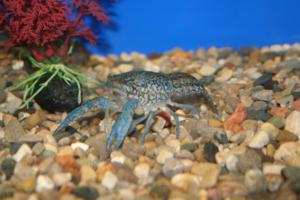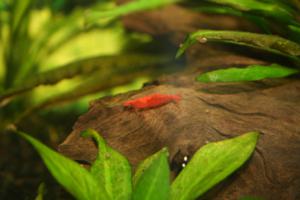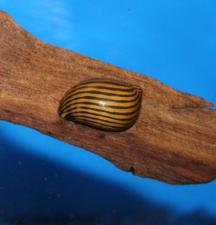
Ghost Shrimp (Whisker Shrimp, Glass shrimp)
Overview: Ghost Shrimp, also known as Glass Shrimp, are excellent scavengers. They are inexpensive and efficient aquarium cleaners that will actively search for any kind of left-over food in your aquarium. Their transparent bodies and frenetic food-searching behavior make Ghost Shrimp an interesting addition to your freshwater aquarium.
Native Range: Farm Raised
Max Length: 2 inches
Water: 68-85° F, KH 3-10, pH 6.5-8.0
Feeding: Omnivore
Behavior & Care: An established freshwater aquarium of at least 10 gallons with plenty of hiding places and a mature substrate are the ideal setup for the Ghost Shrimp. It should be housed with small peaceful fish that will not pose a threat of eating these shrimp. |
|

Blue Crawfish
Overview: Crayfish are also known as crawfish, crawdads, mudbugs, and yabbies; they resemble and are related to lobsters. Crayfish most commonly live in freshwater, only a few have the ability to survive in salt water.
Native Range: United States
Water: 70-78 F, pH: 7.0
Feeding: Omnivore
Behavior & Care: Crayfish like to have a place to hide. The crayfish will molt, shed its exoskeleton. During the few hours after the molt, the crayfish has a soft exoskeleton and is vulnerable to predators. The larger the crayfish grows, the longer the time is in between molts. Crayfish have gills for breathing underwater, but can also breathe air. |
|

Amano Shrimp (Caridina multidentata)
Overview: The Amano Shrimp is often credited as starting the Dwarf Shrimp hobby in The United States. The Amano Shrimp was introduced to the American aquarium hobby around 1994. Takashi Amano, the author of The Natural Aquarium and noted planted tank author, wrote in his book about the effectiveness of the Amano Shrimp in controlling Algae in the planted tank.
Native Range: Southeast Asia
Max. Length: 2+ inches
Water: 70 - 80 F, pH: 6.5 - 8.0
Feeding: Omnivore
Behavior & Care: Amano Shrimp are rather simple to care for in the Home Aquarium. Undemanding when it comes to water parameters, as long as pH, hardness, and temperature extremes are avoided in a well-established aquarium the Amano Shrimp will grow healthy and happy. |
|

Bamboo Shrimp (Atyopsis moluccensis)
Overview: Bamboo shrimp (flower shrimp, wood shrimp and marble shrimp), are any of several species of the genus Atyopsis. They are filter-feeding shrimp, two to three inches long, which are sold in the United States and United Kingdom as community tank invertebrates.
Native Range: Southeast Asia
Water: 70 - 78 F, pH: 6.5 - 7.8
Feeding: Filter Feeder
Behavior & Care: As aquatic pets, bamboo shrimp can often require extremely low maintenance in a large enough and mature tank. They are filter feeders which collect microorganisms resulting from the waste produced by other inhabitants of the aquarium, and as such they are absolutely harmless to all tropical fish, because they have fans in place of claws. |
|

Cherry Shrimp (Neocaridina heteropoda)
Overview: The cherry shrimp is a variety of freshwater shrimp from Taiwan which is commonly kept in aquariums. The natural coloration of the shrimp is green-brown; however the red morph is much more frequently sold.
Native Range: Taiwan
Max. Length: 2 inches
Water: 57- 86 °F, pH: 6.5 - 8.0
Feeding: Herbivore
Behavior & Care: Red cherry shrimp are easy to care for in the home freshwater aquarium and breed well. They will adapt to a wide range of water conditions, and will thrive in the same conditions as many common aquarium fish. The red cherry shrimp is a non-aggressive shrimp. Periodically a shrimp will shed its exoskeleton, leaving an empty white ghost of itself caught in the plants or drifting around the tank. This should be left in the tank, as the shrimp will eat it to recover the valuable minerals it contains. |
|

Orange Bee Shrimp (Caridina cantonensi)
Overview: The Orange Bee Shrimp is one of the oldest shrimp species in the hobby. It has been in the hobby for almost a decade. However, over time it has become quite rare and difficult to acquire. This species is making a comeback however and should start spreading through the hobby as more breeders sell their stock.
Native Range: Asia
Max. Length: 1.5 inches
Water: 70 - 80 °F, pH: 6.2 to 6.9
Feeding: Omnivore
Behavior & Care: The Orange Been shrimp is more resilient towards organic waste than its sensitive relative the Crystal Red shrimp, but this doesn't mean that the aquarist can neglect the water quality. Keep the water clean if you want your Orange Bee shrimps to thrive. Carry out frequent water changes and do not overfeed. |
|

Crystal Red Shrimp (Caridina cf. cantonensis)
Overview: The Crystal Red Shrimp is the selectively bred red color variant of the Bee Shrimp. Originally selectively bred in Japan for its red coloration the Crystal Red Shrimp is becoming one of the most popular Dwarf Shrimp across the globe.
Native Range: South East Asia
Max. Length: 2 inches
Water: 62 - 72 F pH: 5.8 - 6.8
Feeding: Omnivore
Behavior & Care: Crystal Red Shrimp are non-aggressive, and are quite active. In an aquarium that has no predators Crystal Red Shrimp will often be observed grazing on algae on aquarium plants, decorations and on the substrate. When fed, the shrimp will often form large groups that are quite striking in appearance. |
|
_300x200.jpg)
White Ghost Lobster
Overview: The White Ghost Lobster is from the rivers and streams of North East Australia, and is one of the larger species of crayfish attaining a total length of up to 12". They are a brilliant white color with relatively small claws for their size. They are generally peaceful towards members of its species and will rarely hunt for fish; which they are generally too slow to catch.
Native Range: Australia, Tank Raised
Max. Length: 1 foot
Water: 68-85° F, KH 3-8, pH 6.5-8.0
Feeding: Omnivore
Behavior & Care: Provide a freshwater aquarium of at least 50 gallons with plenty of rocks, and a substrate with a moderate grain size or finer for the White Ghost Lobster to burrow in. They are generally peaceful towards their own kind, but require room for territories, and a larger aquarium will be needed if housing more than one. |
|

Rabbit Snail (Tylomelania sp.)
Overview: Rabbit snails come in a pretty amazing spectrum of colors and patterns. Some are orange, some are canary yellow, and some are black, while others are black with tiny white speckles. They have long cone-shaped shells that vary in coloration and pattern from species to species.
Native Range: Sulawesi
Max. Length: 2 inches
Water: 62 - 72 F pH: 5.8 - 6.8
Feeding: Omnivore
Behavior & Care: Tylomenia are excellent scavengers, and will feed on left over foods. They will also consume algae and plant matter. |
|

Zebra Snail (Neritina natalensis)
Overview: The Zebra Nerite Snail is one of the most, if not the most, popular nerite snail in the hobby. Its coloration is a beautiful golden shell with black jagged-edged stripes running down it.
Native Range: South Africa and Florida
Max. Length: 2 inches
Water: 72F-76, pH: 6.0 - 8.3
Feeding: Algae eater
Behavior & Care: The Zebra Nerite Snail can tend to escape from a tank and make its way outside of the tank. It is considered a tidal snail and can live outside of water. Simply pick them up and put them back inside of the tank, they will survive as long as they have not been out of the tank for too long. |
|

Assassin Snail (Clea Helena)
Overview: Clea helena is a species of freshwater snail with an operculum, an aquatic gastropod mollusk in the family Buccinidae, the true whelks, most of which are marine.
Native Range: Asia, especially in Indonesia, Malaysia, and Thailand
Max. Length: 1-2 inches
Water: pH: 7.0-8.2
Feeding: Carnivore
Behavior & Care: Assassin Snails are known to be extremely active. The idea that snails are slow and plodding is definitely challenged by this gastropod. Assassin snails will scale plants, glass, large stones, and wood with surprising speed when hunting for food. |
|







_300x200.jpg)




